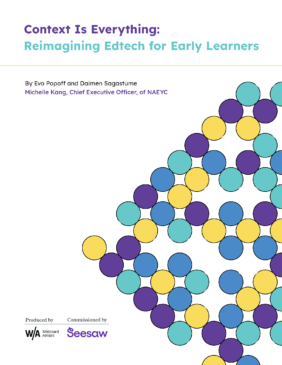Key ideas and recommendations for edtech developers

Children aren’t small adults. This might seem obvious to parents and educators, but, as we learned in our research for the recently released whitepaper, Context Is Everything: Reimagining Edtech for Early Learners, some designers (and purchasers) of edtech tools for elementary learners neglect this basic fact – which may explain in part why 70% of teachers in a recent Seesaw survey indicated that the edtech tools they use in their classrooms do not adequately meet the unique needs of early learners.
We witnessed this firsthand in our work with organizations that were exploring opportunities to incorporate speech recognition into education solutions for younger learners. At the time, speech recognition was an emerging technology, and the machine learning that drove most of the systems had been trained using adult voices. This created a major problem because, as noted by Patricia Scanlon, who founded Soapbox Labs to develop the first speech technology platform for young children, “adults are not children; children have shorter, thinner vocal tracks.” We realized then that, ultimately, a crucial element of the technology simply hadn’t been designed for children—and this phenomenon presented itself again and again.
In our interviews for the paper, we were able to uncover a few reasons why it has been difficult to create and deploy edtech solutions that have been specifically designed for children. First, there is a challenge inherent in the logistics of involving young children in the design process. It is crucial to include representative sets of students who would use the software in the iterative design process to understand what is and isn’t working. However, without the correct connections, resources, or expertise it can be hard for some to get that exposure, leaving them to use adults as proxies for their students’ needs and considerations. Moreover, children don’t learn in isolation, so a user-centered design process – which includes the entire learning loop of parents, educators, and peers in evaluating the experience – is critical.
Second, on the consumer side, considerations relating to cost and efficiency have led district administrators to adopt tools, like learning management systems, which are designed for and used in their middle and high schools—but perhaps not as effective in elementary classrooms. Finally, most parents believe their children already spend too much time in front of a screen, particularly in preschool and elementary school; historically, elementary educators have balked at incorporating technology in their classrooms as well. This resistance disincentivized companies from investing in developing tools specifically for younger students.
The good news is that those resistant attitudes toward edtech have started to shift as parents and elementary teachers increasingly find value in technology when used appropriately and with balance. Additionally, a growing body of research (including our own) provides guidance for edtech developers who are interested in designing tools for young learners.
In our paper, we organized this guidance around three categories of design principles focused on supporting Joyful, Connected, and Inclusive learning experiences. Here, we would like to focus on two that we think are particularly important and perhaps counterintuitive: designing edtech with the child’s offline experience in mind and centering joyful learning in edtech.
Design Edtech with the Child’s Off-Line Experience in Mind
First, to truly support these young students, edtech solutions need to be carefully designed with their developmental needs and classroom realities in mind. While it may seem counterintuitive if you are developing, for instance, a learning app for young students, good edtech built for early learners should integrate into their physical environment and augment and work alongside them. Solutions should augment hands-on, experiential learning rather than supplant it. A big part of this means striking the balance between on- and off-line learning. When thinking through solution design, consider the use case: how will the tool be used? How can it support social learning with peers, students, or families? How will a student be able to translate online activities into the real world? And share off-line activities back to their community? Solutions should enhance, not replace, tangible interactions and opportunities for students to engage with the broader classroom environment. Edtech should also recognize the crucial partnership between school and families in elementary classrooms. Parents or guardians are a child’s first teachers, so tools should engage families as partners with their own set of interactions into the learning process, not just provide information outwards. Actively inviting families to participate is crucial and can spark excitement, further engaging students in the learning process. As such, ensuring connectivity not just between students and teachers, but also with peers and parents, is critical.
Centering Joyful Learning in Edtech
Extensive research highlights the importance of joy, curiosity, and play in early learning. A longitudinal study found that a child’s school enjoyment level by age six is positively associated with their academic achievement through adolescence. This is a concept that most people probably intuitively understand—all the individuals we interviewed certainly got it. But there is a tension here as elementary schools turn to edtech for somewhat un-playful tasks like assessing and monitoring learning. It’s easy to conflate “joyful learning” with “fun,” however. A tool that, for instance, provides students with an academic experience—let’s say solving some math problems—followed by a fun experience—e.g., a mini-game—is missing the point.
The learning should happen through the joyful experience; indeed, it’s more likely to happen through joyful experiences. Designing joyful edtech means creating playful, multimodal, active, and creative hands-on learning experiences that provide engaging opportunities to gain skills while nurturing a lifelong love of learning. Children feel like they are genuinely included in the learning and take on the task confidently. These tools can be fun, but, more importantly, they should inspire curiosity that leads to further inquiry. Delight, not “drill and kill,” should drive solution design.
To ensure edtech solutions meet the unique needs of early learners, developers should ask themselves the following questions:
- Do our solutions support joyful, active learning? Do they promote student relationships and connect online learning with real-world activities?
- Are we just communicating with families or inviting them into the learning process? Have we made assumptions that overlook variability among early learners?
- How can we balance screen time and ensure both online and off-line learning experiences? Do tools fade into the classroom background while enhancing the learning context?
- Does the solution align with child development research on how young children learn best through play, exploration, and joy?
- Does the solution consider the major changes in physical and academic capabilities as children grow?
By considering these factors, edtech developers can design tools and solutions that uniquely meet early learners’ needs, supporting their overall well-being and learning goals from an early age. Children are certainly not adults, but we should do all we can to equip them with the tools they need to learn, grow, and explore so they can reach their fullest potential as they grow up.

Daimen Sagastume is a director at Whiteboard Advisors, where he specializes in advocacy and growth enablement across the Pre-K-12 education space. He comes to Whiteboard Advisors after five years at Emerson Collective, where he managed the education philanthropy investment portfolio, in addition to incubating a seed stage ed-tech company, Uppercase, which aims to democratize access to the best teaching knowledge in the world.

Evo Popoff is Senior Vice President at Whiteboard Advisors. He has spent much of his career working closely with states, districts and schools to help them develop and implement effective school turnaround, after-school, online, and blended-learning programs.

